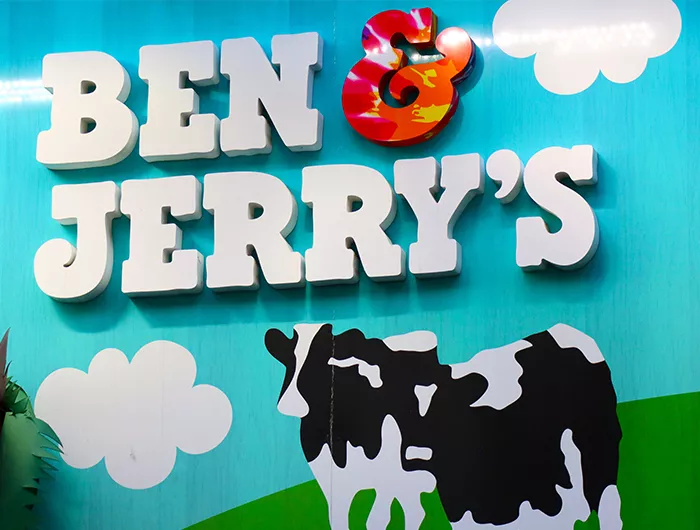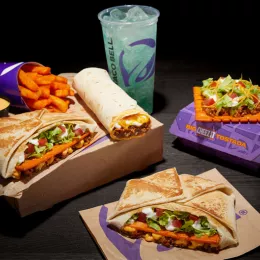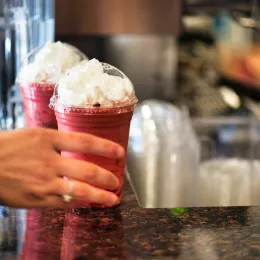How many calories are in a ‘small’ Ben & Jerry’s ice cream?

Walter Cicchetti - stock.adobe.com.
This content is free. Because CSPI takes no corporate or government donations, we rely on supporters like you to fuel our content. Donate now. |
Ever check the menu board at a Ben and Jerry’s scoop shop to see how many calories you’re getting? It’s not so simple. Take the menu board we recently saw at Ben and Jerry’s Silver Spring, MD, store:

You’ll see a range of calories for each flavor on the list—like “250-750” for Butter Pecan, “230-690” for Chocolate Chip Cookie Dough, or “240-720” for Chunky Monkey. (Unfortunately, the FDA allows restaurant chains to use those ridiculously wide ranges.)
So you might expect a “small” size ice cream to clock in at the low end of those ranges (typically 200 to 250 calories). Nope. That’s what you’d get in a “kids” size cup, which is 1 scoop. (That’s clear if you order online, but not from the scoop shop’s menu board.)
A “small” ice cream (2 scoops) typically has 400 to 500 calories—about what you’d get in a McDonald’s Quarter Pounder with Cheese (520).
A “large” ice cream (3 scoops) typically ranges from 600 to 750 calories. That’s roughly a third of the 2,000 calories that most adults should eat in an entire day.
Of course, anyone can order a “kids” size. But you’ll pay almost as much ($6.09 at the Silver Spring shop) for that single scoop as you would for the 2 scoops in a “small” ($6.75) or the 3 scoops in a “large” ($8.00). (Check your menu board before you order. Prices and scoops-per-size can vary from shop to shop.)
How much added sugar and saturated fat are in a Ben and Jerry’s “small”?
Restaurants with at least 20 locations are only required to disclose calories on their menus, but they must disclose saturated fat, total sugar, sodium, and other nutrients on request. Ben and Jerry’s website lists those other nutrients—plus added sugar—under "Scoop Shop Flavors" on its website. (To see the complete nutrition info per 1 scoop, click the flavor, then scroll down and click “Ingredients.”)
Take the popular The Tonight Dough. A “small” (2 scoops) packs 500 calories, 12 grams of saturated fat (60% of a day’s recommended limit), and 38 grams of added sugar (76% of a day’s max). That’s 9 teaspoons of added sugar. Chunky Monkey, Gimme S’more!, New York Super Fudge Chunk, and Churray for Churros! are in the same ballpark.
Non-dairy flavors are better for the planet, but not necessarily for your health. A “small” Chocolate Chip Cookie Dough made with oat milk has 420 calories, 60% of a day’s sat fat, and 80% of a day’s added sugar. The almond milk version is similar, with 460 calories and roughly 70% of a day’s added sugar and saturated fat. (The sat fat comes from coconut oil.)
When it comes to dairy ice creams, the fruit flavors are a tad less extreme than those with cookie dough, chocolate, caramel, etc. A “small” Strawberry ice cream has 320 calories, 10 grams of saturated fat (50% of a day’s max), and 26 grams of added sugar (52% of a day’s worth). The new Mango ice cream is similar.
Only a “small” sorbet like Berry Berry Extraordinary cuts the calories down to 200 and the sat fat to zero, though you still get 68% of a day’s added sugar (34 grams). Sigh.
Since sorbets have the fewest calories, scoop shops use them to show the calorie range for a “small” in the price section of the menu board. In Silver Spring, for example, the menu board says, “Small $6.75” next to “160-570.” (Note: The range for a “small” should be “200-520,” according to Ben and Jerry’s press office. Apparently, some scoop shops haven’t updated their menu boards.)
How many calories are in the cone that comes with the ice cream?
An ordinary sugar cone has just 50 calories. But why stop there? Get it chocolate-dipped and you’re up to 110 calories. And, like other chain restaurants, Ben and Jerry’s keeps raising the stakes. A waffle cone bumps you up to 160 calories. And a chocolate-dipped version hits 230 calories. Fill it with a “large” Chunky Monkey, and you’re at 950 calories. Yikes.
How to make sense of calorie labels on restaurant menus
It’s not just ranges like those at Ben and Jerry’s. Restaurant menus can be confusing, thanks to salad dressings, side dish choices, customized bowls, and calorie levels like “420/530/640” for a single item. Ditto for online ordering platforms and phone apps. Keep reading:
Support CSPI today
As a nonprofit organization that takes no donations from industry or government, CSPI relies on the support of donors to continue our work in securing a safe, nutritious, and transparent food system. Every donation—no matter how small—helps CSPI continue improving food access, removing harmful additives, strengthening food safety, conducting and reviewing research, and reforming food labeling.
Please support CSPI today, and consider contributing monthly. Thank you.
More on restaurant food
Peter’s Memo: Cut the salt
Industry Accountability

How to order a healthy takeout meal from any restaurant
Healthy Eating

Why food waste matters to your pocketbook and the planet
Sustainability

How bad is the Taco Bell Big Cheez-It menu? Very.
Sodium

Added sugar: New York City leads warning label efforts
Food Labeling


